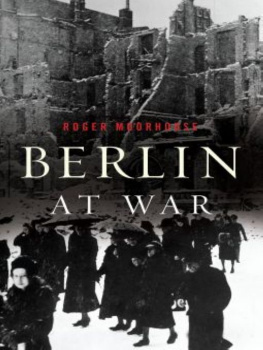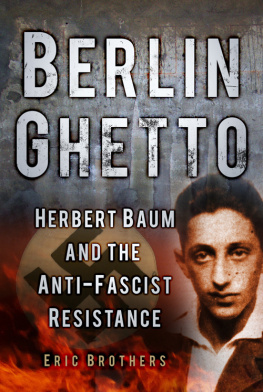Heinz Rein
BERLIN FINALE
Translated by Shaun Whiteside
The bullet in the middle of the chest, the brow split wide Thats how you lifted us high in the air on a bloody board! High in the air amidst wild cries, so that our tortured gesture Might be an eternal curse to him who ordered us to kill!
Ferdinand Freiligrath,
The Dead to the LivingEris shakes her serpents
All Gods flee
And thunder clouds hang
Heavily on Ilium
Schiller,
CassandraLisbon, San Francisco and Tokyo were destroyed by earthquakes in a matter of minutes; it took several days for the fires of Rome, Chicago and London to be extinguished. The fires and earthquakes that raged upon the spot on the earths surface marked by the geographical intersection of 52 degrees 30 minutes northern latitude and 13 degrees 24 minutes eastern longitude lasted almost two years. They began on the clear, dark night of 23 August 1943 and ended in the rainy grey of 2 May 1945.
It was at this spot, thirty-two metres above sea level, that the city of Berlin lay nestled in an Ice Age dune until that night when destruction began its baleful course. It had risen from a fishing village to a fortress town, to the seat of the margraves and prince-electors of Brandenburg, to the residence of the kings of Prussia and the capital of the imperial and republican German Reich. It had come into being with the advance of colonizing German tribes into the settlement zones of the Wends and Slavs, and had lain for centuries far from the tribal territories of German culture. It had become a bulwark in the German colonial nation, an outlier of the old German West and an outpost of the new German East, and was late in entering the Reich and still later in becoming the centre of German history. It consists of a multiplicity of small, middle-sized and large towns, of villages, settlements, farms and barbicans that lay scattered between the Havel and the lake-land to the east of the Marches, and merged together towards the old fortress towns of Berlin and Klln. The scourge of history worked very sparingly here, there were few traces of its rise and its transformations, but they refined an ambiguous appearance with certain noble features that were firmly engraved upon the citys core. There are innumerable traces of the citys downfall, which began as soon as it was elevated to the capital of the Greater German Reich. Devastating conflagrations, storms of steel and carpet-bombing have transformed the citys lively face into the grimace of a deaths head.
On 23 August 1943 the city was dealt its first wound when 1,200 British Air Force planes launched their first great strike. The southern suburbs of Lankwitz, Sdende and Lichterfelde were rendered into a smoke-blackened island of death in the middle of the sea of life. But this time it was not sea engulfing the island, it was the island ousting the sea, because soon it was no longer alone. Everywhere, in Moabit and Friedrichstadt, around Ostkreuz and in Charlottenburg, at Moritzplatz and around the Lustgarten, islands of death appeared, their shores advancing further and further and amalgamating, until at last the whole city became a land of death with a few patches of water that still contained a trace of life. Each attack broke a piece from the structure of the city, destroyed property and lowered living conditions.
Whole districts were turned to barren rubble. Large factory sites, flanked by unused chimneys, became a wilderness of shattered hangars and rusting machinery, pipes, metal bars, wires and joists. Many streets were still lined with the faades of buildings that looked like living houses but were now nothing but cynical backdrops. Mutilation has left other districts so disfigured as to be unrecognizable, filling them with wheezing, struggling life. The stumps of their mutilated buildings rise naked and ugly among the heaps of rubble, they loom like islands from the sea of destruction, torn and shredded, the spars of roofs which have been blown away like ribs stripped of skin, the windows as blind as eyes with permanently lowered lids, occasionally blinking glassily, the walls bare, having shed their plaster, looking like ageing women whose faces have been ruthlessly wiped of foundation and rouge.
In other parts of the city the destruction is less complete, but in those rows of houses the wars claws have torn great gaps, often revealing a surprising view of the inner courtyards of buildings. Having escaped the airstrikes, they are visible from the streets for the first time, and so can no longer hide their ugly countenances behind the shoddy flamboyance of their external faades; in a sense, the hurricane of explosions has raised the curtain on them. These streets hold all degrees and varieties of destruction, from total annihilation to shelters cobbled together from cardboard and cellulose. There are houses whose roofs have burned away, and others consumed by flames up to the first floor, and some that have been emptied by the blasts, their window frames, shutters and doors ripped from their bodies, the dry skeletons of the roof beams protruding like bones from corpses. There are flats that hang like swallows nests above the exploded faades because the bombs fell at an angle, and basements that have survived the pressure of the collapsing houses. Only smoking stove-pipes among the piles of rubble suggest that people are vegetating in there as if in a foxs den. The anatomy of the houses presents itself unadorned, the stairs and the partition walls, the lift shafts and chimneys are like bones, the gas and water pipes like arteries, the radiators and bathtubs like entrails. The remains of life are wasting away amidst the jungle of ruins, and nature alone begins to clothe the naked destruction, covering the piles of debris with greenery.
The wide network of the public transport system, woven from the many tram and bus lines, the overground and the underground, the Stadtbahn and the Ringbahn, the local and suburban trains, has been torn to pieces, provisionally repaired with the most makeshift of patches. The timetables change from one day to the next because the destruction of platforms, overhead wires, tunnels, viaducts, bridges and stations has led to restricted services, cancellations and diversions.
The typical features of the city, those classically bourgeois buildings clustered around the island on the Spree and the swiftly flowing axis of Unter den Linden, which once lent it its characteristic features, created by the masterly hands of Schinkel, Schlter and Eosander, Rauch, Knobelsdorff and Langhans, have been erased even before Speers drawing-board architecture could supplant it. Its landmarks now are high-rise bunkers, accumulators of anxiety, inhalers of flight, olive-drab lumps of concrete with anti-aircraft guns which, heavy as gigantic mammoths, stamp down the grass of the Friedrichshain, the Humboldthain and the Zoological Garden, no conciliatory feature mitigating the brutal functionality of their architecture. To these are added the many bunkers, both below and above ground, in the squares and by the stations of the city centre, in the estates and leafy colonies of the periphery, and their most primitive variety, the slit trenches, carved into parks, patches of forest and the embankments of the suburban railways.
At the beginning of the war the city had 4,330,000 inhabitants, but in April 1945 there are only 2,850,000. The men have been conscripted to military service, they have been recruited to the Todt Organisation, to the Volkssturm territorial army, they have been sent elsewhere with their factories. The women have fled to areas supposedly safe from air attacks, the old and the sick have been evacuated, the young called up for work duty, the schoolchildren lodged in rural evacuation camps, and the Jews removed. The decline in population is in fact far greater than that, because among the 2,850,000 inhabitants of the city 700,000 are foreign forced labourers from conquered and subject countries, Ukrainians, Polish, Romanians, Greeks, Yugoslavians, Czechs, Italians, French, Belgians, Dutch, Norwegians, Danish, Hungarians and those Jews and inmates saved from the death camps in the east because they were fit for work. They are crammed in barracks on the desolate stretches between the city and the suburbs, in sites cleared of bomb damage, usually along the railway lines, hastily thrown up and surrounded by barbed wire fences. They bear a striking similarity to the emergency settlements that stand grey and bleak between patches of woodland and allotments, except that here (as everywhere else) the barbed wire is replaced by the invisible network of a system of surveillance and control, calculated down to the tiniest detail.













